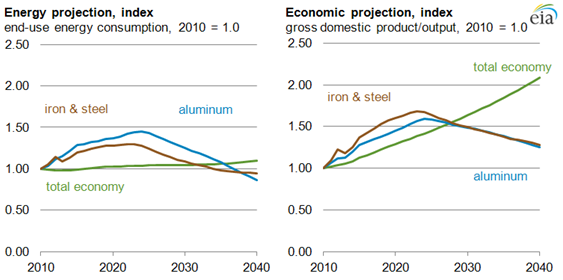
Metallurgical industries are key parts of energy-intensive manufacturing

In 2010, metals manufacturing used 1.4% of the nation's energy and was estimated by the Commerce Department's Bureau of Economic Analysis to provide 0.6% of the nation's gross output of goods and services. The metals industry includes both primary production of aluminum, iron, and steel, as well as the manufacture of commodity products, such as metal sheets or tubes, and specialty products. Overall, the industrial sector consumed an estimated 31 quadrillion Btu in 2012, nearly a third of energy consumed in the United States.
Energy consumption in the aluminum industry has declined in recent years while consumption in iron and steel has remained relatively flat. Output for these two industries was flat over the last decade, except 2008-09 when the recession caused a sharp output decline.
Because of links within the supply chain, changes in the metals industries can have broad economic effects. EIA projections show a declining share of both energy use and output in the overall economy from the metals industries in the next 20 to 30 years. However, for the next 10 to 20 years, energy use and output should accelerate in both aluminum and iron and steel, driven by low energy costs and increasing demand for key products.

The most recent EIA data for the manufacturing sector are available in the Manufacturing Energy Consumption Survey (MECS2010). For more discussion of the industrial sector and individual industries, see EIA's Industry Analysis Briefs and the Annual Energy Outlook 2013 (AEO2013).